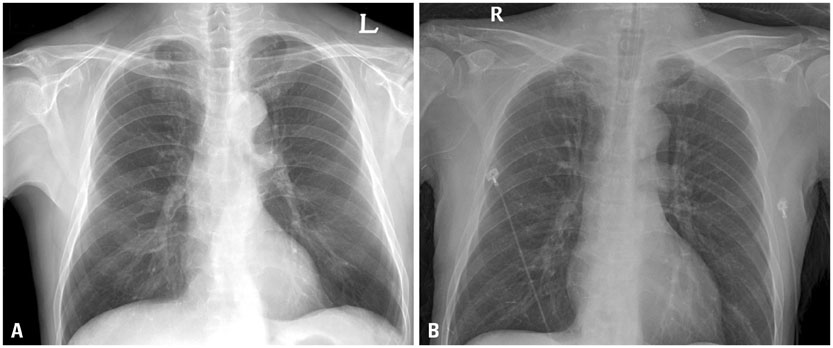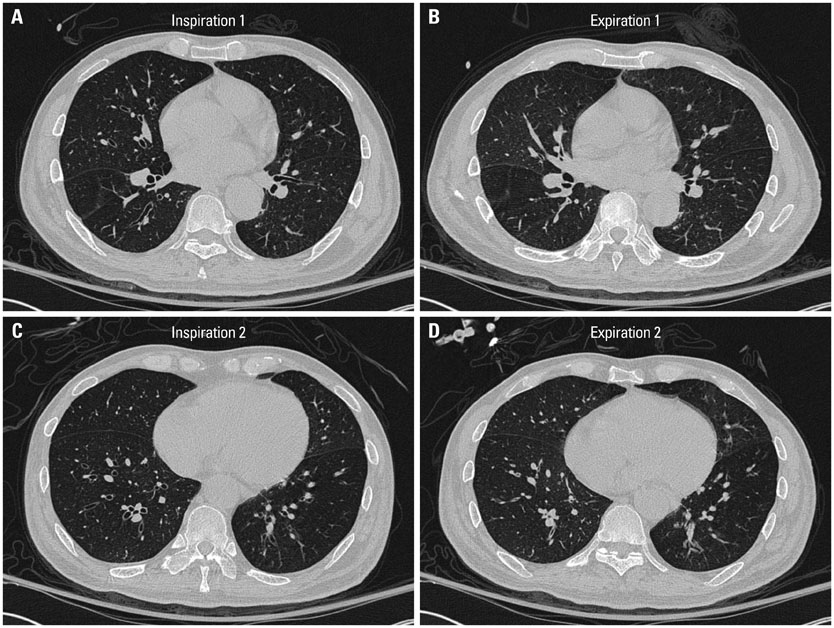Yonsei Med J.
2015 Mar;56(2):578-581. 10.3349/ymj.2015.56.2.578.
Bronchiolitis Obliterans Associated with Stevens-Johnson Syndrome: A Case Report
- Affiliations
-
- 1Department of Internal Medicine, Asan Medical Center, University of Ulsan College of Medicine, Seoul, Korea.
- 2Division of Allergy and Clinical Immunology, Asan Medical Center, University of Ulsan College of Medicine, Seoul, Korea.
- 3Division of Pulmonary and Critical Care Medicine, Asan Medical Center, University of Ulsan College of Medicine, Seoul, Korea. cmlim@amc.seoul.kr
- KMID: 2070041
- DOI: http://doi.org/10.3349/ymj.2015.56.2.578
Abstract
- We report a case of bronchiolitis obliterans associated with Stevens-Johnson syndrome. A 59-year-old man presented with respiratory distress that gradually worsened over 3 months. He had been diagnosed with Stevens-Johnson syndrome 3 months before admission. He had no history of previous airway disease. On physical examination, expiratory breathing sounds were not audible, and a chest X-ray revealed a hyperinflated lung. A pulmonary function test indicated a severe obstructive pattern. Computed tomography scans of inspiratory and expiratory phases of respiration showed oligemia and air trapping, and both were more prominent on expiration view than on inspiration view. The pathogenesis of bronchiolitis obliterans associated with Stevens-Johnson syndrome is largely unknown.
MeSH Terms
-
Anti-Bacterial Agents/therapeutic use
Bronchiolitis Obliterans/etiology/*radiography/therapy
Bronchoscopy
Dyspnea/*complications
Fatal Outcome
Humans
Male
Middle Aged
Radiography, Thoracic
Respiratory Distress Syndrome, Adult/*etiology/therapy
Respiratory Function Tests
Roxithromycin/therapeutic use
Stevens-Johnson Syndrome/*complications/drug therapy
Tomography, X-Ray Computed/methods
Tracheostomy
Anti-Bacterial Agents
Roxithromycin
Figure
Cited by 1 articles
-
HLA Allele Frequencies in 5802 Koreans: Varied Allele Types Associated with SJS/TEN According to Culprit Drugs
Hye Jung Park, Young Joo Kim, Dong Hyun Kim, Junho Kim, Kyung Hee Park, Jung-Won Park, Jae-Hyun Lee
Yonsei Med J. 2016;57(1):118-126. doi: 10.3349/ymj.2016.57.1.118.
Reference
-
1. Roujeau JC, Kelly JP, Naldi L, Rzany B, Stern RS, Anderson T, et al. Medication use and the risk of Stevens-Johnson syndrome or toxic epidermal necrolysis. N Engl J Med. 1995; 333:1600–1607.
Article2. Stitt VJ. Stevens-Johnson syndrome: a review of the literature. J Natl Med Assoc. 106; 80:104.3. Kim CK, Kim SW, Kim JS, Koh YY, Cohen AH, Deterding RR, et al. Bronchiolitis obliterans in the 1990s in Korea and the United States. Chest. 2001; 120:1101–1106.
Article4. Yatsunami J, Nakanishi Y, Matsuki H, Wakamatsu K, Takayama K, Kawasaki M, et al. Chronic bronchobronchiolitis obliterans associated with Stevens-Johnson syndrome. Intern Med. 1995; 34:772–775.
Article5. Tsunoda N, Iwanaga T, Saito T, Kitamura S, Saito K. Rapidly progressive bronchiolitis obliterans associated with Stevens-Johnson syndrome. Chest. 1990; 98:243–245.
Article6. Date H, Sano Y, Aoe M, Goto K, Tedoriya T, Sano S, et al. Living-donor lobar lung transplantation for bronchiolitis obliterans after Stevens-Johnson syndrome. J Thorac Cardiovasc Surg. 2002; 123:389–391.
Article7. Sugino K, Hebisawa A, Uekusa T, Hatanaka K, Abe H, Homma S. Bronchiolitis obliterans associated with Stevens-Johnson Syndrome: histopathological bronchial reconstruction of the whole lung and immunohistochemical study. Diagn Pathol. 2013; 8:134.
Article8. Shah AP, Xu H, Sime PJ, Trawick DR. Severe airflow obstruction and eosinophilic lung disease after Stevens-Johnson syndrome. Eur Respir J. 2006; 28:1276–1279.
Article9. Gerhardt SG, McDyer JF, Girgis RE, Conte JV, Yang SC, Orens JB. Maintenance azithromycin therapy for bronchiolitis obliterans syndrome: results of a pilot study. Am J Respir Crit Care Med. 2003; 168:121–125.
Article10. Sugino K, Kimura K, Sano G, Kato N, Takagi K, Tsuchiya K, et al. [An autopsy case of obliterative bronchiolitis associated with Stevens-Johnson syndrome]. Nihon Kokyuki Gakkai Zasshi. 2006; 44:511–516.
- Full Text Links
- Actions
-
Cited
- CITED
-
- Close
- Share
- Similar articles
-
- One case of bronchiolitis obliterans associated with Stevens-Johnson syndrome due to mycoplasma pneumoniae infection
- Bronchiolitis Obliterans Associated with Stevens-Johnson Syndrome
- A Case of Stevens-Johnson Syndrome in a Hypoxic Brain Injury Patient Treated with Carbamazepine
- Clinical Study of Stevens-Johnson Syndrome
- A Case of Secondary Milia Associated with Stevens-Johnson Syndrome



